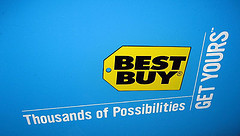Mutiple Best Buy Pricing Errors Are A Reminder To Always Keep An Eye On The Checkout Scanner
Robyn says that she recently went to Best Buy to pick up some gifts for her boyfriend. (We’re assuming he got those gifts yesterday, but in case you are Robyn’s boyfriend and have yet to open your presents, consider this a spoiler alert.)
One of the gifts was a 32GB flash drive that was listed on the shelf at $24.99, in spite of the fact that Best Buy was also selling a slower version of a comparable drive for $5 more. She compared item numbers and barcodes to make sure she was getting the right thing. She even confirmed it all with a Best Buy employee, who offered to ring up her purchase.
But when he scanned the flash drive, it suddenly showed up as $39.99, fifteen dollars more than what it was supposed to be. The employee grabbed another drive off the shelf to verify and yep, $39.99.
“I asked the sales associate if he could call a manager so that we could confirm and adjust the price of $24.99, as I wasn’t paying $39.99,” writes Robyn. “Instead he tried to sell me on the slower flash drive that was priced at $29.99. I asked to speak to a manager again. No luck. He just kind of looked at me.”
Not making any headway there, Robyn took her issue to a clerk at the front of the store, where it was confirmed that not only was the flash drive showing up with the wrong price, so was the other item — a memory card reader — that Robyn intended to buy for her boyfriend.
At least this employee was able to correct the issue for Robyn — a difference of $20 between what was showing up on the cash register and what she was supposed to pay. We don’t know if this also fixed the price in the system for those two items so that no other customers would be overcharged.
What we do know is that when Robyn went back to buy another item — a stylus for touch screens listed at $11.99 — that item was also showing up with the wrong price of $19.99.
At least this time, the employee at the register didn’t require all manner of verifying and buck-passing.
“The cashier was quick to adjust the price to $11.99,” writes Robyn. “She actually didn’t even verify it herself, and instead took my word, which I found surprising.”
While Robyn’s Best Buy is (hopefully) an anomaly among retailers. The 2011 survey of retailers in California did put electronics stores on the higher end of stores with pricing errors, averaging around 2.5% of all purchases showing up higher than they should be when scanned at the register. Considering that items at electronics stores are generally pricier than what you’d pay at the grocery, that small percentage of overcharges can add up to a lot of money over time.
So Robyn’s story is a very good example (or three good examples) of why it helps to get to the register with the price of each purchase noted on a piece of paper or jotted down on your smartphone, so you can just quickly compare to what shows up on the register’s screen.
Want more consumer news? Visit our parent organization, Consumer Reports, for the latest on scams, recalls, and other consumer issues.


